This document is for HP OfficeJet 6950, 6951, 6954, 6956, 6958, 6962, OfficeJet Pro 6960, 6968, 6970, 6974, 6975, and 6978 All-in-One printers.
HP OfficeJet 6900 Printers - Black or Color Ink Not Printing, Other Print Quality Issues
The quality of a printed document or photo is not as expected. The procedures in this document should help with streaked or faded printouts, color or black ink not printing, documents with blurred or fuzzy text, ink streaks or smears, and other print quality problems.
note:If you see an Incompatible, Incompatible Cartridge or Defective Cartridge message for the Cyan cartridge and have an HP Officejet 6810, 6820, 6950, 6960, 8010, 8010e, or HP OfficeJet Pro 6230, 6830, 6960, 6970, 8020, 8020e, 8030, or 8030e series printer, see HP OfficeJet Printers - 'Incompatible Cartridge' message for more help.
note:If you see an “0x6100004a” error, your printer must be serviced. See the step at the end of this document to contact HP for service.
note:Rough handling at the store or during installation can cause print quality problems with newly installed ink cartridges. If you see print problems with newly installed ink cartridges, wait for a few hours for the automatic servicing routine to complete, and then try to print again.
Step 1: Reinstall the print driver (Windows only)
If you cannot print color from a Windows computer, uninstall and reinstall the printer software. Skip this step if your printer is able to print in color.
-
Remove the printer from the devices list.For steps on removing the printer from the devices list, go to Uninstall HP printer software and drivers.
-
Go to HP Customer Support - Software and Driver Downloads, and then install the latest software for your printer.
Try to print. If these steps resolved the issue, you do not need to continue troubleshooting.
Step 2: Clean the printhead
The printhead could be clogged, and you might need to clean the printhead several times to restore print quality. Use an automated tool from the printer control panel to clean the printhead.
caution:Never turn off the printer when ink cartridges are not installed. To avoid issues that require cleaning the printhead or that can damage the ink system, always replace ink cartridges as soon as possible, and always turn off the printer using the Power button.
-
From the printer control panel, open the Setup
 menu.
menu.
-
Open the Printer Maintenance menu.
-
If necessary, open the Tools menu, and then touch Clean Printhead.A test page prints.
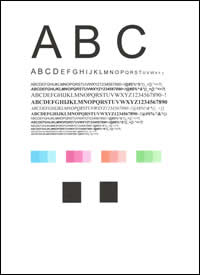
-
Examine the test page.
-
If the print quality is unacceptable, touch Clean Again to continue the next level of cleaning. If necessary, repeat these steps for the third cleaning cycle.
note:
If the printhead is badly clogged, it might require another cleaning cycle. If so, wait 30 minutes before you perform all three levels of cleaning again. -
If the print quality is acceptable, touch Done.
-
Try to print. If these steps resolved the issue, you do not need to continue troubleshooting.
Step 3: Use genuine HP cartridges
HP recommends that you use genuine HP ink or toner supplies. HP cannot guarantee the quality or reliability of non-HP or refilled cartridges. If you do not use genuine HP cartridges, the steps in this document might not resolve the issue. To check the authenticity of your cartridges, go to the HP anti-counterfeit webpage (in English).
|
Ink cartridge description
|
United States and Canada
|
Europe, Middle East, and Africa
|
Latin America
|
Asia Pacific
|
|
Black ink cartridge
|
HP 902 Black
HP 902XL Black
HP 906XL Black
|
HP 903 Black
HP 903XL Black
HP 907XL Black
|
HP 904 Black
HP 904XL Black
HP 908XL Black
|
HP 905 Black
HP 905XL Black
HP 909XL Black
|
|
Cyan ink cartridge
|
HP 902 Cyan
HP 902XL Cyan
|
HP 903 Cyan
HP 903XL Cyan
|
HP 904 Cyan
HP 904XL Cyan
|
HP 905 Cyan
HP 905XL Cyan
|
|
Magenta ink cartridge
|
HP 902 Magenta
HP 902XL Magenta
|
HP 903 Magenta
HP 903XL Magenta
|
HP 904 Magenta
HP 904XL Magenta
|
HP 905 Magenta
HP 905XL Magenta
|
|
Yellow ink cartridge
|
HP 902 Yellow
HP 902XL Yellow
|
HP 903 Yellow
HP 903XL Yellow
|
HP 904 Yellow
HP 904XL Yellow
|
HP 905 Yellow
HP 905XL Yellow
|
note:HP 906XL, 907XL, 908XL, and 909XL ink cartridges are not compatible with the OfficeJet 6950 All-in-One Printer series.
Purchase replacement cartridges and other supplies from the HP Store or local retailers.
Step 4: Check for ink smears on the back of printouts
If there are smears of ink on the back of your printouts, you can use an automated tool to resolve the issue.
-
Load plain white paper in the input tray.
-
From the printer control panel, open the Setup
 menu.
menu.
-
Open the Printer Maintenance or Tools menu.
-
Touch Clean Page Smears or Clean Smear.The printer might make some noise for approximately one minute.
-
Wait until the page is out of the printer before you remove it.
Try to print. If these steps resolved the issue, you do not need to continue troubleshooting.
Step 5: Make sure you are using the appropriate paper for your print job
The quality and type of paper can affect the print job. Follow these guidelines to make sure the paper is appropriate. If it is not, load an appropriate paper type.
-
Load the paper print side down in the input tray. Many papers have printing and nonprinting sides, such as photo paper and envelopes. Usually, the smoother side is the "print side," and sometimes the non-print side has a logo of the paper manufacturer on it.
-
Do not use wrinkled or curled paper. Use only clean, wrinkle-free paper.
-
Use the correct paper type for your project.
-
For everyday text documents, plain paper with ColorLok technology works well. Paper with ColorLok technology is industry-standard paper that works well with HP ink.
-
For documents with dense printing, such as high contrast graphics or photos, use HP Advanced Photo Paper for best results.
-
Some paper might not absorb ink as well as others. If your prints smear easily, make sure you are using a recommended paper.
-
-
Store photo paper in its original packaging inside a resealable plastic bag. Store the paper on a flat surface in a cool, dry place. Load 10-20 sheets of photo paper only when you are ready to print, and then put the unused paper back in the packaging.
-
Try using a different paper. This determines if the problem is related to the paper.
Step 6: Check the print settings
Sometimes the print settings can affect the print quality. Select your operating system, and then check the print settings to make sure they are appropriate for your print job.
Step 7: Check the estimated ink levels
Check estimated ink levels to see if any ink cartridges are critically low or empty.
note:Ink level warnings and indicators provide estimates for planning purposes only. When an indicator shows low ink levels, consider having a replacement ink cartridge available to avoid possible printing delays. You do not need to replace ink cartridges until print quality becomes unacceptable.
On the printer control panel, touch the Ink Level Indicator icon  . The control panel displays estimated ink levels.
. The control panel displays estimated ink levels.
 . The control panel displays estimated ink levels.
. The control panel displays estimated ink levels.
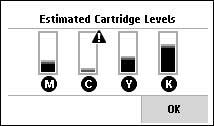
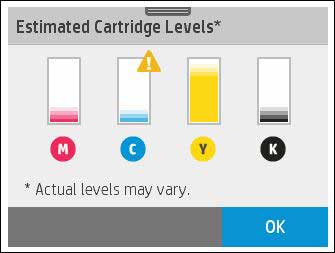
Consider replacing cartridges marked  or
or  when print quality becomes unacceptable.
when print quality becomes unacceptable.
 or
or  when print quality becomes unacceptable.
when print quality becomes unacceptable.
-
If none of the ink cartridges are low on ink, you do not need to replace them yet. Skip to the step to make sure the ink cartridges are vented and seated correctly.
-
If any of the ink cartridges are low on ink, continue to the next step to replace them.
Step 8: Replace any low or empty cartridges
Replace any critically low or empty ink cartridges, and then try to print again. Skip this step if all ink cartridges display full ink levels.
-
Open the ink cartridge access door.The carriage moves to the ink cartridge access area.
note:
If the scanner lid is open, the ink cartridge access door does not open.
-
Wait until the carriage stops moving before you continue.
-
Press the tab inward on the front of the old ink cartridge to release it, and then pull up on the ink cartridge to remove it from the slot.
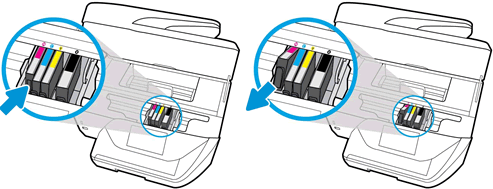
-
Remove a new ink cartridge from its package, and then pull the orange pull-tab straight back.
caution:
Make sure you remove the orange pull-tab and plastic wrap completely before you remove the orange cap in the next step. Otherwise, ink might leak from the ink cartridge. When you remove the plastic wrap, the paper label on the top of the ink cartridge tears slightly, which is necessary to properly vent the ink cartridge.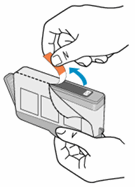
-
Hold the ink cartridge by its sides, and then twist the protective orange cap counter-clockwise to snap it off the ink cartridge.
caution:
Do not touch the copper-colored contacts or the ink nozzles. Touching these parts can result in clogs, ink failure, and bad electrical connections.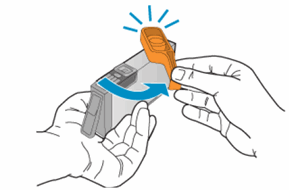
-
Gently bend the tab away from the ink cartridge.
caution:
Be careful not to bend the tab out more than 1.27 cm (0.5 in). Moving the tab too far might damage the ink cartridge or cause the tab to break.-
Bend the tab away from the ink cartridge
-
Do not bend the tab more than 1.27 cm (0.5 in)
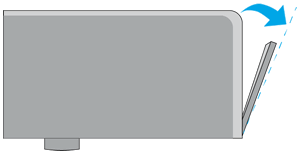
-
-
Turn the ink cartridge so that the ink cartridge contacts face downward, and then match the label color with the color dot on the carriage.
-
Slide the ink cartridge into its slot, and then gently press the ink cartridge down until it snaps into place.
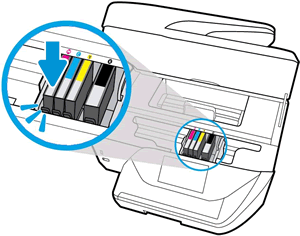
-
Repeat these steps to install any new ink cartridges.
-
Close the ink cartridge access door.

Try to print. If replacing any low or empty cartridges resolved the issue, you do not need to continue troubleshooting.
Step 9: Make sure the ink cartridges are properly vented and seated correctly
Check the vents on the top of the ink cartridges. If they are clogged or obstructed, the ink cartridges might not work properly, which can affect print quality.
note:To avoid print quality issues and dried out ink cartridges, do not leave any ink cartridges outside the printer for longer than 30 minutes.
-
Turn on the printer, if it is not already turned on.
-
Open the ink cartridge access door.The carriage moves to the center of the printer.

-
Wait until the carriage stops moving before you continue.
-
Press the tab inward on the front of the old ink cartridge to release it, and then pull up on the ink cartridge to remove it from the slot.

-
Examine the vent area above the HP logo on the top of the ink cartridge.
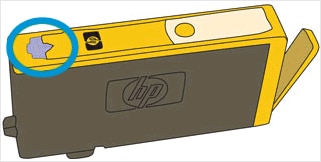
-
If the ink cartridge still has the orange pull-tab attached, pull to remove it.
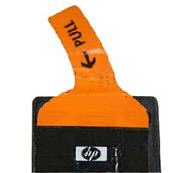
-
If the vent is clogged, use a straight pin to gently remove excess adhesive from the vent.
-
Clogged vent
-
With a straight pin, gently remove excess adhesive from the vent
-
Unclogged vent

-
-
Turn the ink cartridge so that the ink cartridge contacts face downward, and then match the label color with the color dot on the carriage.
-
Slide the ink cartridge into its slot, and then gently press the ink cartridge down until it snaps into place.

-
Repeat these steps to inspect the vents on each of the ink cartridges.
-
Make sure each ink cartridge is firmly installed in its slot. Run your finger along the top of the ink cartridges to feel for any that are protruding, and if any are, press down firmly until each ink cartridge snaps into place.
-
Close the ink cartridge access door.

Try to print. If these steps resolved the issue, you do not need to continue troubleshooting.
Step 10: Print a Print Quality Diagnostic Page
Print a Print Quality Diagnostic Page, and then evaluate the results.
-
Load plain white paper in the input tray.
-
From the printer control panel, open the Setup
 menu.
menu.
-
Open the Reports or Tools menu.
-
Touch Print Quality Report.A Print Quality Diagnostic Page prints.
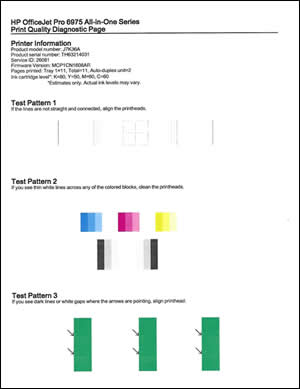
Step 11: Examine Test Pattern 1
Evaluate Test Pattern 1 on the Print Quality Diagnostic Page to make sure the lines are straight and connected.

-
If the lines in Test Pattern 1 are straight and connected, skip to the step to examine Test Pattern 2.
-
If the lines in Test Pattern 1 are not straight and connected, continue to the next step to align the printhead.
Step 12: Align the printhead
Aligning the printhead can resolve errors with Test Pattern 1.
-
Load plain white paper in the input tray.
-
From the printer control panel, open the Setup
 menu.
menu.
-
Open the Printer Maintenance or Tools menu.
-
Touch Align Printhead.An alignment page prints.

-
Wait until the page is out of the printer before you remove it.
Continue to the next step.
Step 13: Print another Print Quality Diagnostic Page
Print another Print Quality Diagnostic Page to examine the lines in Test Pattern 1 again.
-
If the lines in Test Pattern 1 are straight and connected, continue to the next step to examine Test Pattern 2.
-
If the lines in Test Pattern 1 are not straight and connected, skip to the step to service the printer.
Step 14: Examine Test Pattern 2
Examine the color blocks in Test Pattern 2 on the Print Quality Diagnostic Page.
Test Pattern 2 with white lines in a color bar

Test Pattern 2 with a missing color block
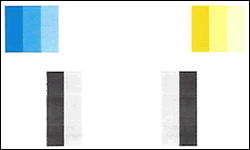
-
If the color blocks in Test Pattern 2 do not show white lines, and are not faded or missing, skip to the step to examine Test Pattern 3.
-
If any of the color blocks in Test Pattern 2 show white lines or are faded or missing completely, continue to the next step to clean the printhead.
Step 15: Clean the printhead
The printhead could be clogged, and you might need to clean the printhead several times to restore print quality. Use an automated tool from the printer control panel to clean the printhead.
caution:Never turn off the printer when ink cartridges are not installed. To avoid issues that require cleaning the printhead or that can damage the ink system, always replace ink cartridges as soon as possible, and always turn off the printer using the Power button.
-
From the printer control panel, open the Setup
 menu.
menu.
-
Open the Printer Maintenance menu.
-
If necessary, open the Tools menu, and then touch Clean Printhead.A test page prints.

-
Examine the test page.
-
If the print quality is unacceptable, touch Clean Again to continue the next level of cleaning. If necessary, repeat these steps for the third cleaning cycle.
note:
If the printhead is badly clogged, it might require another cleaning cycle. If so, wait 30 minutes before you perform all three levels of cleaning again. -
If the print quality is acceptable, touch Done.
-
Continue to the next step.
Step 16: Print another Print Quality Diagnostic Page
Print another Print Quality Diagnostic Page to examine the color blocks in Test Pattern 2 again.
-
If there are no defects in Test Pattern 2, continue to the next step.
-
If there are defects in Test Pattern 2, clean the printhead again.
-
If there are still defects in Test Pattern 2 after a second printhead cleaning, you can try to clean the printhead a third time or skip to the step to service the printer.
Step 17: Examine Test Pattern 3
Examine the green columns in Test Pattern 3 on the Print Quality Diagnostic Page.
Test Pattern 3 with white gaps in the columns
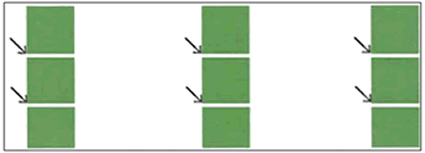
-
If there are no defects in Test Pattern 3, you do not need to continue with the steps in this document.
-
If the columns in Test Pattern 3 display dark lines or white gaps where the arrows are pointing, continue to the next step.
Step 18: Align the printhead
Aligning the printhead can resolve errors with Test Pattern 3.
-
Load plain white paper in the input tray.
-
From the printer control panel, open the Setup
 menu.
menu.
-
Open the Printer Maintenance or Tools menu.
-
Touch Align Printhead.An alignment page prints.

-
Wait until the page is out of the printer before you remove it.
Continue to the next step.
Step 19: Print another Print Quality Diagnostic Page
Print another Print Quality Diagnostic Page to examine the color blocks in Test Pattern 3 again.
-
If there are no defects in Test Pattern 3, you do not need to continue with the steps in this document.
-
If the columns in Test Pattern 3 still display dark lines or white gaps where the arrows are pointing, continue to the next step.
Step 20: Service the printer
Service or replace your HP product if the issue persists after completing all the preceding steps.
Go to Contact HP Customer Support to schedule a product repair or replacement. If you are in Asia Pacific, you will be directed to a local service center in your area.
To confirm your warranty status, go to HP Product Warranty Check. Repair fees might apply for out-of-warranty products.
note:Keep a print sample that shows the problem. If the ink cartridges, printhead, or printer is replaced under warranty, the support agent will request the print sample. If the printer is returned to HP, the print sample must be returned with the printer. Place the sample in the output tray when you package your printer for shipping.
Enter a topic to search our knowledge library
What can we help you with?
Need Help?

